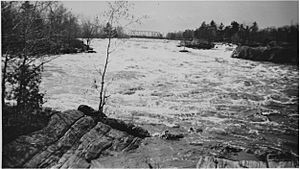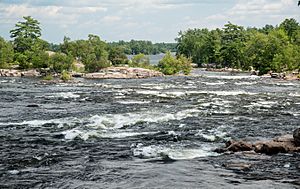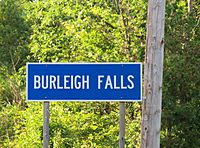Burleigh Falls facts for kids
Burleigh Falls is a unique spot in Peterborough County, Ontario, Canada. It's a natural water feature and also a small community. The falls mark the border between two areas: North Kawartha to the north and Selwyn to the south.
The "falls" are actually more like a fast-moving river section or a series of small waterfalls. The water drops more horizontally than straight down. This happens because the water flow narrows between Lovesick Lake and Stoney Lake. Long ago, this area was even called the "Burleigh chute."
For many years, Indigenous Mississaugas families have lived near Burleigh Falls. Around the early 1900s, five families settled on Island 31. They had been forced to leave their original homes by a Canadian government policy. Jack Jacobs was a leader among them. He was the first to build a home there, inspiring others to join him.
However, in 1912, Jack Jacobs was forced to leave his home again. This happened because the government needed the land to build a dam and Lock 28 for the Trent-Severn Waterway. These families then moved to the shores of Lovesick Lake. Their community became known as the "Burleigh Falls Indians."
Today, this community is called Kawartha Nishnawbe. It has about 1,200 members. In 2002, a court decided that the Kawartha Nishnawbe people are a distinct Mississauga First Nation. The court also said they have special rights from old agreements, called Treaty rights. These rights are protected by Canada's laws.
Contents
Burleigh Falls Bridge
The bridge at Burleigh Falls is part of Ontario Highway 28. This highway is a main road that goes north and south. Even though the two sides of the water are less than 100 meters apart, it used to be very hard to cross. The area has many large lakes and rivers. Before the bridge, the shortest way to get across by land was over 70 kilometers! Much of that route had no roads.
Before the 1950s, people crossed Stoney Lake by boat in summer and on the ice in winter. An iron bridge, built in the 1860s, helped travelers. The current bridge, which is a strong T-beam design, was finished in 1953.
Lock 28: A Water Highway Helper
In the past, most travel in central Ontario happened on the water. This was because of the many lakes and rocky land. To make water travel easier, a huge system of locks and dams was built. This system is called the Trent-Severn Waterway. It connects Lake Ontario to Georgian Bay.
At Burleigh Falls, the fast-moving water and rocks made it hard for boats to pass. So, Lock 28 was built just north of the falls. This lock allows boats to go around the difficult water. It's often called the Burleigh Falls Lock.
The lock was first made of two sections, each lifting boats about 4 meters. The lock canal was about 190 meters long and was blasted through solid rock. Later, it was replaced with one lock that lifts boats 7.3 meters. The lock was completed in 1887. Limestone from this area was used to build other nearby locks too.
Control Dam: Managing Water Levels
As part of the Trent-Severn Waterway, a long control dam was also built just above the falls. This dam helps manage the water level on Lovesick Lake. It keeps the lake deep enough for larger boats to travel. It also makes sure there is enough water to operate the lock.
Village of Burleigh Falls
With the bridge and lock built, a small village grew up nearby. It's also called Burleigh Falls. Businesses opened to serve people like lumberjacks, steamship passengers, and other travelers. In more recent years, the village serves tourists and the many people who have cottages on the two large nearby lakes.
On Burleigh Island, which is about 11 acres, a hotel was built by John Holmes in 1857. The first post office in the village opened in 1877. Today, there is also a public dock at Burleigh Falls.
Outdoor Activities
Boating, especially canoeing, has always been popular around Burleigh Falls. In 1974, a local group started the Burleigh Falls Canoe Company. They began making traditional cedar-strip canoes because many people wanted them.
The area has also been a favorite spot for fishermen for a very long time. More recently, people who love kayaking have come to enjoy the rapids.





